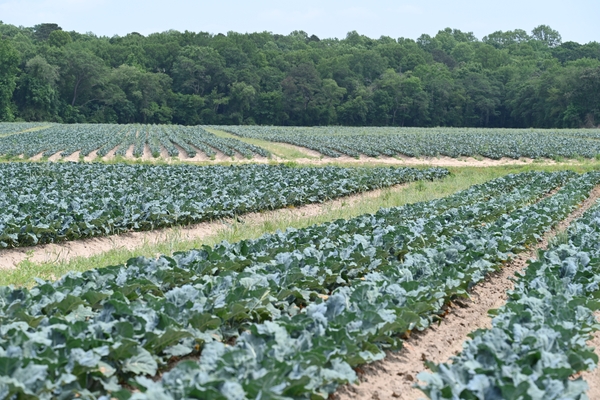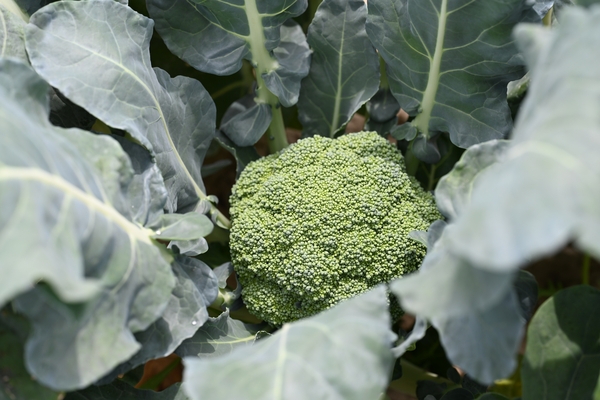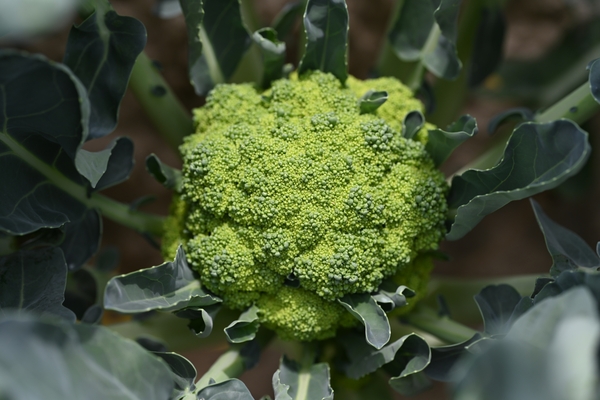History
Sprouting broccoli was first cultivated in the Mediterranean region, possibly in Cyprus or Crete, though the precise origin remains uncertain. It evolved from leafy cole crops in the northern Mediterranean around the 6th century. The name "broccoli" comes from the Italian word "brocco," meaning "sprout" or "shoot," which is derived from the Latin "brachium," meaning "arm" or "branch."
While sprouting broccoli was domesticated long ago, it only gained popularity outside the Mediterranean in recent times. It was introduced to the USA from Italy in the 1800s but didn't become popular until the 1920s. By the 1940s, broccoli had become a common vegetable in America and soon surpassed cauliflower in popularity. Its popularity in the USA spread globally, leading to its reintroduction and newfound appreciation in Europe. Today, broccoli is extensively cultivated and is an important economic crop in Europe, North America, and parts of Central and South America, eastern Asia, and Australia.
Botany
Sprouting broccoli (B. oleracea Group Italica) is a frost-tolerant, cool-season annual or biennial dicot, suited to temperate and subtropical regions worldwide. It tolerates heat better than other brassicas, with optimal head development between 54-68°F (Figure 2). Higher temperatures lead to poor head formation (Figure 3), while growth slows below 41°F. Properly acclimated plants can endure brief periods at 20°F.
Seedlings resemble other B. oleracea crops, with thick, leathery leaves in shades from grayish-blue to green. The plant has a shallow root system with a prominent taproot. The inflorescence consists of yellow or white flowers, forming a compact head that expands as it matures. Full-grown plants reach about 47 inches tall and 20 inches wide, relying on bees for cross-pollination.
The seed pods (siliques) are 2-4 inches long, splitting open to release 20-40 seeds, which mature 50-90 days after fertilization. A well-pollinated plant can yield up to 0.5 pounds of seeds, with approximately 8,490 seeds per ounce.
Types and Cultivars
In the Americas, parts of Asia, and southern Europe, most sprouting broccoli varieties are annuals that form heads of immature flower buds 50-70 days after emergence without needing vernalization. Biennial types, more common in northern Europe, require chilling below 50°F for floral development.
Sprouting broccoli cultivars are categorized as early, medium, or late-maturing. Late-maturing and overwintering cultivars are typically biennial and need vernalization. Key types include purple sprouting, purple cape, purple Sicilian, white sprouting, and calabrese, which can be annual or biennial.
Calabrese types are the most commercially popular, often as hybrids rather than open-pollinated cultivars. Hybrid cultivars, known for their productivity and uniformity, require new seeds each year since they do not grow true-to-type. True sprouting broccoli heads are clusters of immature flower buds that open into flowers.
Broccoli's main inflorescence forms at the top of an unbranched stem, with green or purple bud clusters and a tall stem. We often distinguish between sprouting broccoli (with multiple smaller heads) and heading broccoli (with a single large head). However, traditionally both are classified as sprouting broccoli, distinct from overwintering types.
Production
Broccoli can be cultivated either by direct seeding or transplanting. Bunching broccoli is often grown from direct seeding using precision planters on raised beds to enhance drainage and support furrow irrigation. Check with your seed supplier to determine if your seeds are treated. If not, soak the seeds at 122°F for 20 minutes. Dry the seeds and then treat them with a labeled fungicide to prevent damping-off. Chemically treated, pelleted, or primed seeds should not be hot-water treated. Hot water seed treatment can decrease germination rates, especially for older seeds (more than one year old) or seeds grown under stressful environmental conditions. You may want to test the germination of a small sample of your seeds both before and after hot water treatment to evaluate the potential effects of the treatment. Treat only the amount of seed you think you will use during a season, as hot water-treated seeds may not remain viable as long as untreated seeds. For more information about seed treatments, please visit: UMass Extension Vegetable Program.
For even emergence, a fine seedbed is required to ensure good seed-to-soil contact, promoting quick and uniform sprouting. When producing bunching broccoli, where two to four heads are bundled with a rubber band, high plant densities with in-row spacing as close as 4 inches optimize head size. To achieve a successful stand, broccoli may be over-seeded and then thinned during the seedling stage. For markets that prefer large-head, single-stalk broccoli, lower plant populations are used. In these cases, in-row spacing ranges from 8 to 24 inches, with double rows spaced 12 inches apart and raised bed-row spacing of 24 to 36 inches, depending on the cultivar. In areas with short growing seasons or for large-head production, broccoli is sometimes transplanted. Transplants are grown in densely seeded beds in fumigated or steam-treated soil or in plug trays within a protected environment. Broccoli transplants are easy to handle due to their minimal root mass and are ready for field planting 4 to 5 weeks after seeding. Storage of field-grown broccoli transplants should not exceed 10 days at 32°F or 5 days at 66°F before planting. Planting dates for broccoli vary by location. In eastern North Carolina, it is recommended to plant in the spring between February 15 and April 15, and for the fall crop, between August 1 and September 15. In western North Carolina, spring planting should be done between April 1 and August 15, while fall planting is not recommended.
Broccoli thrives in various mineral and organic soils with adequate moisture and fertility. Soil fertility varies by region and should be tested before planting. A soil pH of 6.0 to 6.5 is ideal, though broccoli can tolerate a pH range of 5.5 to 6.8. Broccoli has a high nitrogen requirement (125-175 lb/a of N) and benefits from fertilizer placed near the plant due to its small root zone. Nitrogen deficiency may cause reduced yields, delayed maturity, and poor quality. Nitrogen is often applied in split applications at planting and again at heading or as a side-dress every 2 to 3 weeks after planting. Broccoli on organic soils may need less additional nitrogen. Excess nitrogen can lead to rapid, poor-quality growth and issues like tip burn in high temperatures. Broccoli also needs sufficient boron (2-3 lb/a) and molybdenum (0.5 lb/a of sodium molybdate). Boron deficiency manifests as yellowing of younger leaves and terminal shoot death, while molybdenum deficiency leads to general yellowing and necrosis of older leaves.
Broccoli can be grown using conservation tillage methods such as no-till, ridge-till, strip-till, or mulch-till. These methods minimize soil disturbance, reduce erosion, conserve moisture, and improve organic matter. Advantages include reduced machinery use, labor, fuel costs, and soil erosion. Disadvantages involve lower soil temperatures, slower germination, increased weed competition, and potential for more pests and diseases.
Broccoli can also be grown using a plasticulture system where thin plastic film is laid over raised beds to create a mulch that drains water effectively. Drip irrigation is commonly used with this system, and soil fumigants can be applied beneath the film to control pests. Transplants are placed through holes in the plastic. After fumigation, the field must be allowed to diffuse the fumigant before transplanting (about 21 days, depending on the fumigant). Plastic mulch helps regulate soil temperature, conserve moisture, and reduce weed competition, though it increases production costs. At the same time, it can lead to higher yields of high-quality heads.
Broccoli generally requires 1 to 1.5 inches of water per week, though this depends on location, cultivar, production system, and soil type. Prolonged low moisture, particularly in sandy soils without plastic mulch, can reduce yield and affect plant development. Drip irrigation is efficient, whereas overhead irrigation may lead to higher disease pressure. Weed control involves shallow tillage, herbicides, mulching, or a combination of methods.
Harvesting
Broccoli is typically harvested by hand with crews moving across several rows using harvesting aids to transport boxes and facilitate trimming and packing. For bunching broccoli, heads are cut while buds are closed and bundled in groups of three or four small heads, approximately 6-8 inches in diameter, held together with a rubber band. The stalks are trimmed to around 8 inches. For single-stalk or crown-cut broccoli, larger heads up to 16 inches in diameter are cut and packed without bunching. Efficient harvesting aims for a single pass through the field, but non-uniform conditions may require multiple passes. Field-packing in cardboard boxes is efficient and reduces handling and bruising. Broccoli degrades quickly and must be transported immediately for cooling to remove field heat.
Postharvest Handling
Broccoli has a high respiration rate and should be cooled immediately after harvest to maintain quality. It should be stored at 32°F with 95-100% relative humidity. Ice, forced-air, or other cooling methods can be used to bring the temperature down quickly. Slurry ice in field-packed boxes helps preserve freshness. Although field packing is becoming more common, broccoli may be transported to grading facilities for trimming, bunching, cooling, and storage. Alternatives to top icing, such as shrink film wrapping, are used in some areas to maintain freshness during long-distance shipment. The film creates a microclimate that helps preserve freshness. Broccoli has a short shelf life (7-10 days), which can be reduced by delays in cooling or temperature fluctuations. It should not be stored with ethylene-producing fruits to avoid yellowing. For processing, broccoli is harvested by hand, bulk collected, and transported to facilities for washing, cutting, and flash freezing.
Publication date: July 22, 2024
N.C. Cooperative Extension prohibits discrimination and harassment regardless of age, color, disability, family and marital status, gender identity, national origin, political beliefs, race, religion, sex (including pregnancy), sexual orientation and veteran status.



